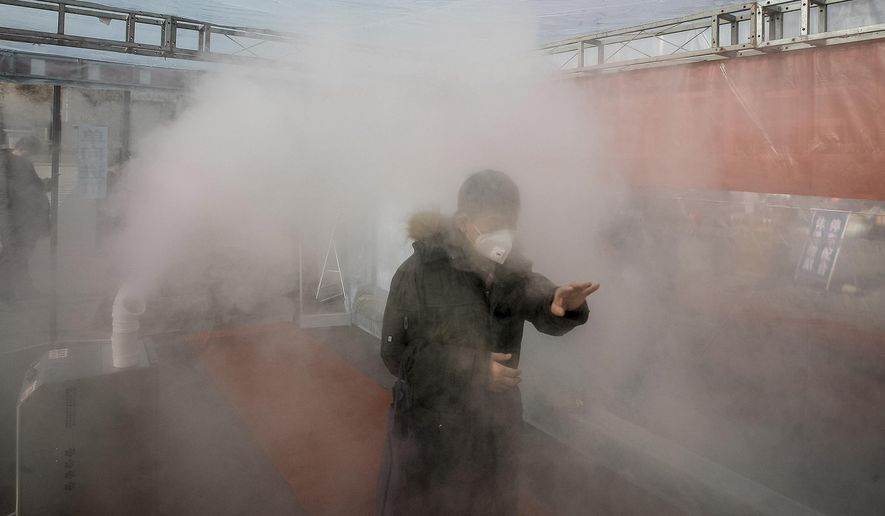Communist China told the world in early January there was no evidence that its Wuhan coronavirus spread human-to-human even as medical whistleblowers were warning of an epidemic and authorities shut down a wild animal market.
“No new cases have been detected since January 3, 2020,” the Wuhan Health Commission said on Jan. 10. “At present, no medical staff infections have been found, and no clear evidence of human-to-human transmission has been found.”
The World Health Organization (WHO) relied on China’s assurances, using some of the exact words.
On Jan. 15, WHO tweeted to the world, “According to the latest information we have, there is no clear evidence of sustained human-to-human transmissions and there are no infections reported among health care workers.”
Five days later, China acknowledged humans-to-human spread, but on Jan. 19 the national health commission told the world the disease was “preventable and controllable.”
The next day, a sharp increase of 136 in confirmed cases brought the total to 200.
On Jan 23, WHO’s emergency committee met in Geneva and then announced it was split on declaring the virus a global health emergency — so it did not.
“The question was whether this event constitutes a Public Health Emergency of International Concern (PHEIC),” said committee chairman Didier Houssin. “The advice to the [director general], which is provided by the Emergency Committee, is that now is not the time. That it’s a bit too early to consider that this event is a Public Health Emergency of International Concern.”
Said Director General Tedros Adhanom Ghebreyesus, “We know that there is human-to-human transmission in China, but for now it appears limited to family groups and health workers caring for infected patients. At this time, there is no evidence of human-to-human transmission outside China. But that doesn’t mean it won’t happen. There is still a lot we don’t know. We don’t know the source of this virus. We don’t understand how easily it spreads. And we don’t fully understand its clinical features or severity.”
Behind the scenes, alarmed Chinese doctors witnessed the influx of patients suffering acute respiratory distress. These physicians in Wuhan knew in December that a new aggressive virus had emerged in their city and tried to get the word out through social media.
They were quickly suppressed by Wuhan police, who picked up Dr. Li Wenliang, an ophthalmologist whose warnings to colleagues were reaching social media.
Police presented Dr. Wenliang with a formal admonition for spreading “rumors.” The police summons and the physician’s warning were posted online.
Dr. Wenliang contracted coronavirus and posted online a photo of himself in a hospital bed. He died Feb. 7. This week, Chinese authorities apologized to his family.
“I don’t think he was rumor-mongering. Hasn’t this turned into reality now?” Li Shuying, his father, told the BBC. “My son was wonderful.”
The Wuhan Health Commission’s Jan. 10 report was published by the news site Quartz.com
The commission said it knew the virus source–––a wild animal market––which had been closed on Jan. 1 well before China acknowledged the epidemic.
“The investigation found that the patients were mainly operating and purchasing staff of the South China Seafood Wholesale Market in Wuhan City,” it said. “On January 1, 2020, the South China Seafood Wholesale Market has been closed and measures have been taken to further strengthen disease prevention guidance and environmental hygiene in public places in the city, especially the farmers’ market management.”
Health officials believe the virus originated in wild bats which are confirmed carriers of coronavirus and were the source for the global 2002 SARS epidemic. It too is believed to have originated in a wild animal market, this one in southern China.
Chinese eat a wide variety of wild animals, including bats, raccoons, groundhogs, civets and snakes.
China’s people’s congress voted on Feb. 24 to close all wild animals markets nationwide.
Western critics say the markets should have been shut down years ago to prevent another SARS-type epidemic.
The delay in alerting the world in December or early January has brought condemnation from President Trump.
The White House National Security Council tweeted on Wednesday: “The Chinese Communist Party suppressed initial reports on the Chinese Virus and punished doctors and journalists, causing Chinese and international experts to miss critical opportunities to prevent a global pandemic.”
WHO declared a global health emergency on Jan. 30. and later deemed the virus a pandemic.
Mr. Trump implemented a travel ban on Feb. 1 on people from mainland China entering the U.S.
China, after over 81,000 confirmed cases and 3,253 deaths, claims to have blocked virtually all new infections.
China’s propaganda machine is now telling of a bizarre and an unfounded conspiracy in which the U.S. Army planted the virus in Wuhan.
• Rowan Scarborough can be reached at rscarborough@washingtontimes.com.




Please read our comment policy before commenting.